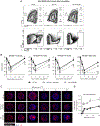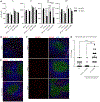Targeting Antigens to CD180 but Not CD40 Programs Immature and Mature B Cell Subsets to Become Efficient APCs
- PMID: 31484732
- PMCID: PMC6761014
- DOI: 10.4049/jimmunol.1900549
Targeting Antigens to CD180 but Not CD40 Programs Immature and Mature B Cell Subsets to Become Efficient APCs
Abstract
Targeting Ags to the CD180 receptor activates both B cells and dendritic cells (DCs) to become potent APCs. After inoculating mice with Ag conjugated to an anti-CD180 Ab, B cell receptors were rapidly internalized. Remarkably, all B cell subsets, including even transitional 1 B cells, were programed to process, present Ag, and stimulate Ag-specific CD4+ T cells. Within 24-48 hours, Ag-specific B cells were detectable at T-B borders in the spleen; there, they proliferated in a T cell-dependent manner and induced the maturation of T follicular helper (TFH) cells. Remarkably, immature B cells were sufficient for the maturation of TFH cells after CD180 targeting: TFH cells were induced in BAFFR-/- mice (with only transitional 1 B cells) and not in μMT mice (lacking all B cells) following CD180 targeting. Unlike CD180 targeting, CD40 targeting only induced DCs but not B cells to become APCs and thus failed to efficiently induce TFH cell maturation, resulting in slower and lower-affinity IgG Ab responses. CD180 targeting induces a unique program in Ag-specific B cells and to our knowledge, is a novel strategy to induce Ag presentation in both DCs and B cells, especially immature B cells and thus has the potential to produce a broad range of Ab specificities. This study highlights the ability of immature B cells to present Ag to and induce the maturation of cognate TFH cells, providing insights toward vaccination of mature B cell-deficient individuals and implications in treating autoimmune disorders.
Copyright © 2019 by The American Association of Immunologists, Inc.
Figures








Similar articles
-
Targeting antigens to CD180 rapidly induces antigen-specific IgG, affinity maturation, and immunological memory.J Exp Med. 2013 Sep 23;210(10):2135-46. doi: 10.1084/jem.20130188. Epub 2013 Sep 9. J Exp Med. 2013. PMID: 24019553 Free PMC article.
-
Targeting Antigen to Clec9A Primes Follicular Th Cell Memory Responses Capable of Robust Recall.J Immunol. 2015 Aug 1;195(3):1006-14. doi: 10.4049/jimmunol.1500767. Epub 2015 Jun 22. J Immunol. 2015. PMID: 26101322
-
NKT-cell help to B lymphocytes can occur independently of cognate interaction.Blood. 2009 Jan 8;113(2):370-6. doi: 10.1182/blood-2008-06-166249. Epub 2008 Oct 2. Blood. 2009. PMID: 18832653
-
Regulation of T follicular helper cell formation and function by antigen presenting cells.Curr Opin Immunol. 2011 Feb;23(1):111-8. doi: 10.1016/j.coi.2010.10.007. Epub 2010 Nov 4. Curr Opin Immunol. 2011. PMID: 21115333 Review.
-
Vaccine Designs Utilizing Invariant NKT-Licensed Antigen-Presenting Cells Provide NKT or T Cell Help for B Cell Responses.Front Immunol. 2018 Jun 4;9:1267. doi: 10.3389/fimmu.2018.01267. eCollection 2018. Front Immunol. 2018. PMID: 29915600 Free PMC article. Review.
Cited by
-
B cell-activating factor (BAFF) from dendritic cells, monocytes and neutrophils is required for B cell maturation and autoantibody production in SLE-like autoimmune disease.Front Immunol. 2023 Feb 27;14:1050528. doi: 10.3389/fimmu.2023.1050528. eCollection 2023. Front Immunol. 2023. PMID: 36923413 Free PMC article.
-
B cell activating factor (BAFF) from neutrophils and dendritic cells is required for protective B cell responses against Salmonella typhimurium infection.PLoS One. 2021 Oct 27;16(10):e0259158. doi: 10.1371/journal.pone.0259158. eCollection 2021. PLoS One. 2021. PMID: 34705890 Free PMC article.
-
Toll-Like Receptor Mediated Activation of Natural Autoantibody Producing B Cell Subpopulations in an Autoimmune Disease Model.Int J Mol Sci. 2019 Dec 6;20(24):6152. doi: 10.3390/ijms20246152. Int J Mol Sci. 2019. PMID: 31817576 Free PMC article.
-
A Novel Gene Delivery Vector of Agonistic Anti-Radioprotective 105 Expressed on Cell Membranes Shows Adjuvant Effect for DNA Immunization Against Influenza.Front Immunol. 2020 Dec 22;11:606518. doi: 10.3389/fimmu.2020.606518. eCollection 2020. Front Immunol. 2020. PMID: 33414788 Free PMC article.
-
CD19-targeting fusion protein combined with PD1 antibody enhances anti-tumor immunity in mouse models.Oncoimmunology. 2020 Apr 21;9(1):1747688. doi: 10.1080/2162402X.2020.1747688. eCollection 2020. Oncoimmunology. 2020. PMID: 32363119 Free PMC article.
References
-
- Sasaki Y, Casola S, Kutok JL, Rajewsky K, and Schmidt-Supprian M. 2004. TNF Family Member B Cell-Activating Factor (BAFF) Receptor-Dependent and -Independent Roles for BAFF in B Cell Physiology. J. Immunol. 173: 2245–2252. - PubMed
-
- Schultz TE, and Blumenthal A. 2016. The RP105/MD-1 complex: molecular signaling mechanisms and pathophysiological implications. J. Leukoc. Biol. jlb.2VMR1215-582R. - PubMed
Publication types
MeSH terms
Substances
Grants and funding
LinkOut - more resources
Full Text Sources
Molecular Biology Databases
Research Materials
Miscellaneous

